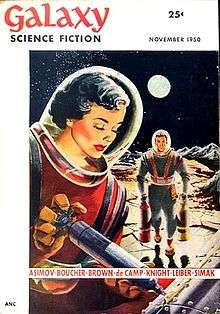Fredric Brown
| Fredric Brown | |
|---|---|
|
Fredric Brown, date unknown | |
| Born |
October 29, 1906 Cincinnati, Ohio |
| Died | March 11, 1972 (aged 65) |
| Occupation | Novelist, short story author |
| Genre | Mystery, Science fiction, Fantasy |
| Notable works |
The Fabulous Clipjoint "Arena" |


Fredric Brown (October 29, 1906 – March 11, 1972[1]) was an American science fiction and mystery writer.
He is known for his use of humor and for his mastery of the "short short" form—stories of 1 to 3 pages, often with ingenious plotting devices and surprise endings, such as the masterpiece "Sentry". Humor and a somewhat postmodern outlook carried over into his novels as well. One of his stories, "Arena", is officially credited for an adaptation as an episode of the American television series Star Trek.
Works
Brown was born in Cincinnati.[1][2] He began to sell mystery short stories to American magazines from 1936.[2] His first science fiction story, "Not Yet the End", was published in the Winter 1941 issue of the magazine Captain Future.[3]
His science fiction novel What Mad Universe (1949) is a parody of pulp SF story conventions. Martians, Go Home (1955) is both a broad farce and a satire on human frailties as seen through the eyes of a billion jeering, invulnerable Martians who arrive not to conquer the world but to drive it crazy.
The Lights in the Sky Are Stars (1952) tells the story of an aging astronaut who is trying to get his beloved space program back on track after Congress has cut off the funds for it.
The short story "Arena" was used as the basis for the episode of the same name in the original series of Star Trek. It was also adapted in 1973 for issue 4 of Marvel Comics' Worlds Unknown.
Brown's first mystery novel, The Fabulous Clipjoint, won the Edgar Award for outstanding first mystery novel.[2] It began a series starring Ed and Ambrose Hunter, and depicts how a young man gradually ripens into a detective under the tutelage of his uncle, an ex–private eye now working as a carnival concessionaire.[2]
Many of his books make use of the threat of the supernatural or occult before the "straight" explanation at the end. For example, "Night of the Jabberwock" is a humorous narrative of an extraordinary day in the life of a small-town newspaper editor.
The Screaming Mimi (which became a 1958 movie starring Anita Ekberg and Gypsy Rose Lee, and directed by Gerd Oswald, who also directed the "Fun and Games" episode of The Outer Limits, the plot of which was similar to Brown's short story "Arena"), and The Far Cry are noir suspense novels reminiscent of the work of Cornell Woolrich. The Lenient Beast experiments multiple first-person viewpoints, among them a gentle, deeply religious serial killer, and examines racial tensions between whites and Latinos in the US state of Arizona. Here Comes a Candle is told in straight narrative sections alternating with a radio script, a screenplay, a sportscast, a teleplay, a stage play, and a newspaper article.
Popularity and influence
The depiction of aliens who are completely alien mentally as well as physically and who are completely bent on humanity's destruction is similar to that of the Arcturians in Brown's What Mad Universe.
His short story "Arena" was voted by Science Fiction Writers of America as one of the top 20 SF stories written before 1965. His 1945 short story "The Waveries"[4] was described by Philip K. Dick as "what may be the most significant—startlingly so—story SF has yet produced." The opening of "Knock" is a complete two-sentence short-short story in itself.
Science fiction and fantasy writer Neil Gaiman has also expressed fondness for Brown's work, having his novel Here Comes A Candle narrated by the character Rose Walker in the collection The Kindly Ones of The Sandman.[5]
Brown was one of three dedicatees of Robert A. Heinlein's Stranger in a Strange Land (the other two being Robert Cornog and Philip José Farmer).[6]
In his non-fiction book Danse Macabre (1981), a survey of the horror genre since 1950, writer Stephen King includes an appendix of "roughly one hundred" influential books of the period: Fredric Brown's short-story collection Nightmares and Geezenstacks is included, and is, moreover, asterisked as being among those select works King regards as "particularly important."
Brown's short story "Naturally" was adapted into Geometria, a short film by director Guillermo del Toro.
Bibliography
Sources
- Seabrook, Jack (1993). Martians and Misplaced Clues: The Life and Work of Fredric Brown. Bowling Green University Popular Press. ISBN 978-0-87972-591-4.
References
- 1 2 Italian short bio at Tuttascuola.net
- 1 2 3 4 Introduction to Rogue in Space, Italian edition, Urania Collezione n. 135, by Giuseppe Lippi
- ↑ Biobliography page at isfdb.org
- ↑ "The Waveries synopsis". Jennre. July 2, 2012.
- ↑ Gaiman, Neil (1985). The Sandman: The Kindly Ones: 10. pp. 21–22.
- ↑ "Heinlein's Dedications". Nitrosyncretic.com.
External links
- Works by Fredric Brown at Project Gutenberg
- Works by or about Fredric Brown at Internet Archive
- Works by Fredric Brown at LibriVox (public domain audiobooks)

- Brown, Frederic (1960). "Earthmen Bearing Gifts". FlashFictionOnline. A short science fiction story.
- Brown, Fredric (1977). "The Weapon". Mind Webs. WHA radio.
- Fredric Brown at the Internet Speculative Fiction Database
- Fredric Brown at Goodreads
- Fredric Brown at the Internet Book List
- Fredric Brown at Memory Alpha (a Star Trek wiki)
- "Frederic William Brown: Career as a mystery writer". TopMystery.com. Includes a photo.
- Webster, Bud. "Past Masters - It's Not the Length, It's What You Do With It". Galactic Central.
- "Author: Fredric Brown". Project Gutenberg.
- "A short animation of 'Knock'". Daily Motion. Video.
- "First Lines: Fredric Brown". Pulp Serenade. June 2011.
